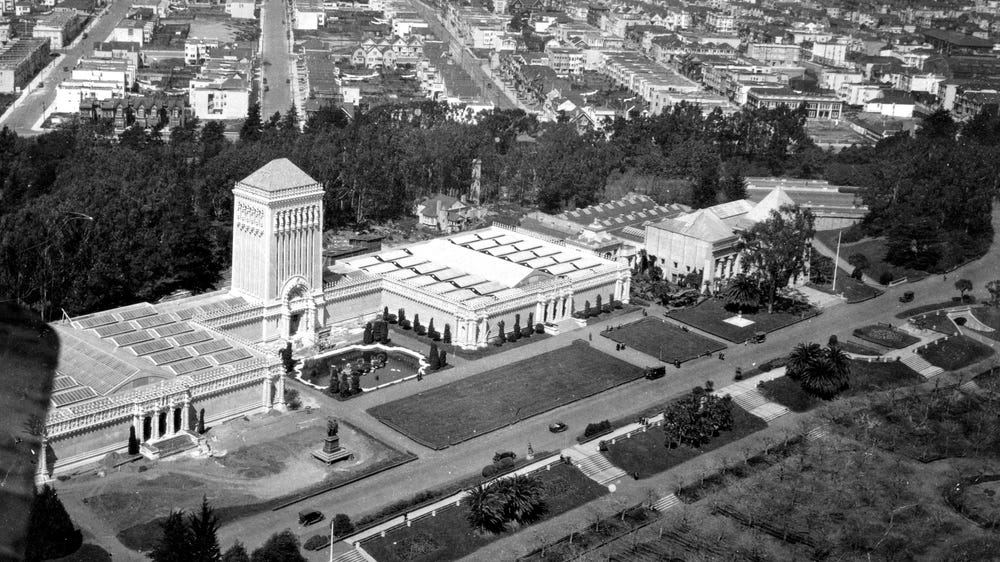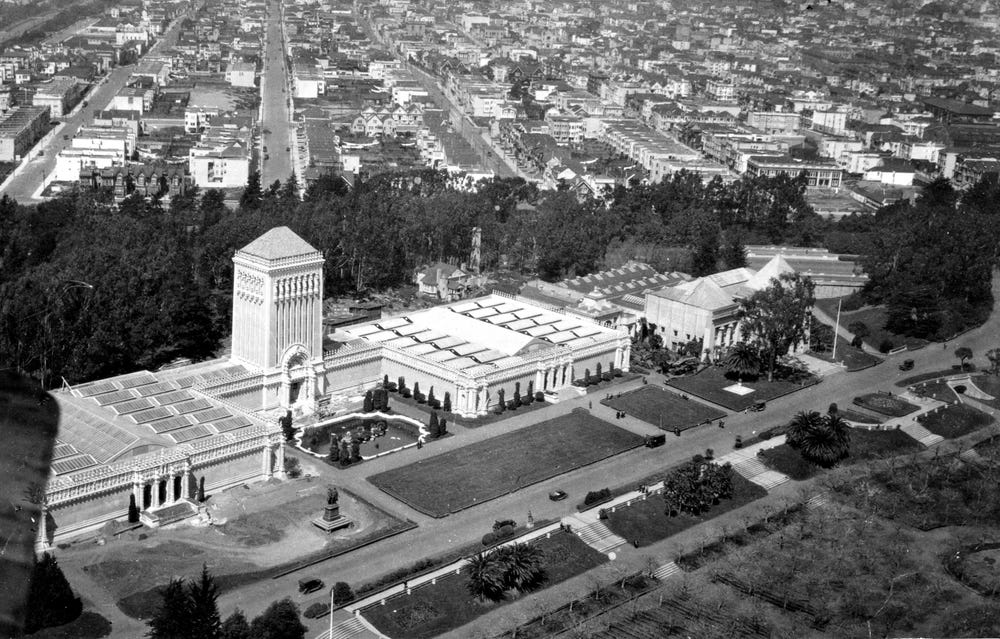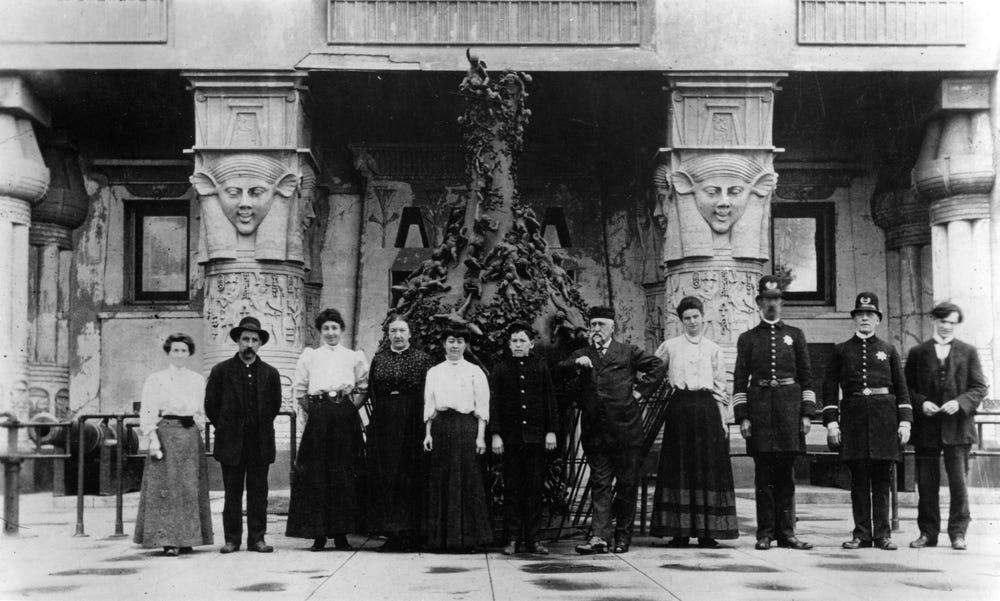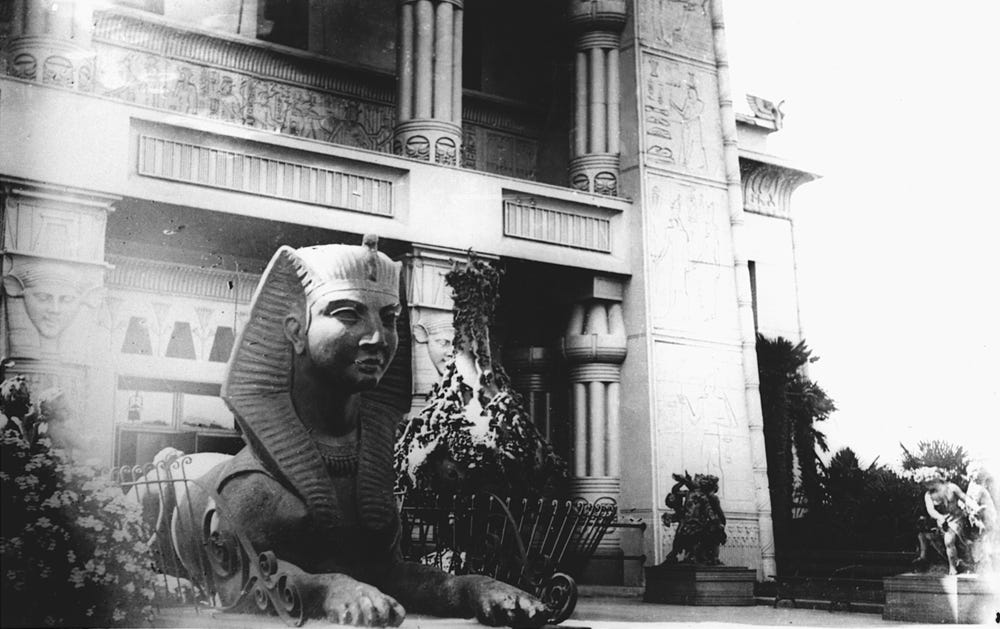de Young history
The de Young museum began as the Fine Arts Building, the only permanent building constructed for the California Midwinter International Exposition in Golden Gate Park in 1894. The Fine Arts Building was designed in an Egyptian Revival style and decoratively adorned with images of Hathor, the cow goddess. The chair of the exposition organizing committee was Michael H. de Young, cofounder of the San Francisco Chronicle. With de Young’s support, the Fine Arts Building was designated as a museum for the people of San Francisco following the exposition, opening on March 23, 1895 as the Memorial Museum. Since then, the de Young has grown from a temporary attraction housing cultural art and artifacts to the foremost museum in the western United States, concentrating on American art, international textile arts and costumes, African art, Oceanic art, and arts of the Americas.
Aerial view of the new M. H. de Young Memorial Museum, ca. 1925
Most of the original collection was acquired during the Midwinter Exposition and from M.H. de Young's personal collection of historical artifacts. Noteworthy acquisitions from the Midwinter Exposition include Gustave Doré’s
The Vintage Vase (Le Poème de la Vigne), 1877 – 1882, and Konstantin Makovsky’s The Russian Bride’s Attire, 1889, both still in the museum’s collection. The museum’s first curator, ethnographer, and cultural historian, Charles P. Wilcomb, also contributed his collection to the initial display. Eleven years after the museum opened, the great earthquake of 1906 caused significant damage to its structure, forcing a year-and-a-half closure for repairs; the museum reopened in November 1907.
The museum's steady development called for a new space to better serve its growing audiences. M. H. de Young responded by planning a large expansion to the original building that would serve as the core of the de Young museum through the 20th century. Louis Christian Mulgardt, the architecture coordinator for the 1915 Panama-Pacific International Exposition, designed an expansion in the Spanish Plateresque style. Construction was completed in 1919, then formally transferred by M. H. de Young to the city's park commissioners. In 1921, the second stage of construction was completed, which added a central section and a tower that would become the museum’s signature feature. The museum retained this basic configuration until 2001. M. H. de Young’s great efforts were honored with the changing of the museum's name to the M. H. de Young Memorial Museum on January 20, 1921. Another addition, a west wing, was completed in 1925, the year de Young died. In that same year, de Young’s large bequest to the museum established the M.H. de Young Endowment Fund. In 1929, the Fine Arts Building, the original museum structure, was declared unsafe and demolished.
In 1931, the board of trustees of the de Young museum appointed Lloyd LaPage Rollins as the first director of the de Young and Legion of Honor, informally uniting the two museums. Rollins dedicated his tenure to organizing the museums’ collections, devoting the de Young to decorative and graphic arts and the Legion to painting and sculpture. He resigned in 1933, and German scholar Dr. Walter Heil became the director of both museums. Heil focused on collecting fine art (painting, sculpture, and decorative arts), making significant acquisitions of European paintings. Though Heil resigned as director of the Legion in 1939, he led the de Young until retiring in 1961.
By the end of the 1940s, the elaborate concrete Plateresque decorations of the museum’s facade were determined to be a hazard, as the salt air from the Pacific Ocean had rusted the supporting steel. In 1949, the decorative concrete ornamentation was fully stripped from the building; the facade remained plain for the next 50 years.
Memorial Museum staff, circa 1900
Following Avery Brundage’s bequest of his magnificent Asian art collection to the city of San Francisco in 1959, the Center for Asian Art and Culture opened in 1966 in a new wing of the museum. In 1973, the Center for Asian Art and Culture was renamed the Asian Art Museum of San Francisco and gained its own board of trustees and administration, but shared both the membership organization (the Museum Society) and its benefits with the de Young. In 1994, city voters overwhelmingly supported a bond measure to renovate the former San Francisco Main Library as the Asian Art Museum’s new home. The Asian Art Museum remained open to the public at the de Young until October 2001, when it closed in preparation for the move. In November 2003, it opened its doors at its new Civic Center location as an independent museum.
In 1972, the de Young formally merged with the Legion to create the Fine Arts Museums of San Francisco (FAMSF). Through this merger, Ian McKibbin White, who had been director of both museums since 1970, reorganized the collections, establishing curatorial departments for painting, sculpture, and decorative arts; prints and drawings; and the arts of Africa, Oceania, and the Americas. The de Young moved its collections of French paintings to the Legion and focused the de Young on American art, international textile arts and costumes, and arts of the Americas, Oceania, and Africa.
Sphinx sculpture and Doré vase in front of the Memorial Museum entrance
In 1989, the de Young suffered significant structural damage as a result of the Loma Prieta earthquake. The board of trustees instituted a project that braced the museum as a temporary measure until a long-term solution could be implemented. On December 31, 2000, the de Young closed to the public for a complete rebuild designed by the Swiss architectural firm Herzog & de Meuron. Historic elements from the former de Young, such as the sphinxes, the original palm trees, and the Pool of Enchantment, were retained or reconstructed, and the new de Young opened on October 15, 2005.
In September 2017, after a long history of promoting contemporary art, the Museums established the Contemporary Art and Programming department.
The de Young ranks within the top 10 most visited art museums in the United States and the most visited in San Francisco. Housed in a state-of-the-art, accessible, and architecturally significant facility, it provides valuable art experiences to generations of residents and visitors.
In the spring of 2020, the de Young celebrated its 125th anniversary. Explore this historic milestone with Google Arts & Culture.
On March 14, 2020, the Fine Arts Museums closed due to the outbreak of the COVID-19 pandemic. In 2021, the de Young reopened to the public.



